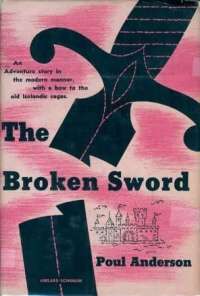The Broken Sword
 Dust-jacket from the first edition. | |
| Author | Poul Anderson |
|---|---|
| Country | United States |
| Language | English |
| Genre | Fantasy novel |
| Publisher | Abelard-Schuman |
Publication date | 1954 |
| Media type | Print (Hardback) |
| Pages | 274 pp |
| ISBN | 0-575-07425-6 |
| OCLC | 59499019 |
The Broken Sword is a fantasy novel by American writer Poul Anderson, originally published in 1954. It was issued in a revised edition by Ballantine Books as the twenty-fourth volume of their Ballantine Adult Fantasy series in January 1971. The original text was returned to print by Gollancz in 2002.[1]
Plot
The book tells the story of Skafloc, elven-fosterling and originally son of Orm the Strong. The story begins with the marriage of Orm the Strong and Aelfrida of the English. Orm kills a witch's family on the land and later half-converts to Christianity, but quarrels with the local priest and sends him off the land. Meanwhile, an elf named Imric, with the help of the witch, seeks to capture the newly born son of Orm. In his place, Imric leaves a changeling called Valgard. The real son of Orm is taken away to elven lands and named Skafloc by the elves who raise him. As the story continues, both Skafloc and Valgard have significant roles in the war between the trolls and the elves.
Reception
Anthony Boucher praised the original edition as "a magnificent saga of the interplay of gods, demigods, faerie, heroes and men."[2] Groff Conklin described the novel as "a rip-snorting, bloody, imitation-Norse epic containing all the elements of faerie".[3] Michael Moorcock declared The Broken Sword superior to Tolkien, calling it "a fast-paced doom-drenched tragedy in which human heroism, love and ambition, manipulated by amoral gods, elves and trolls, led inevitably to tragic consequences."[1] E. F. Bleiler, commenting on the revised edition, declared that "The first portion of this novel is perhaps the finest American heroic fantasy, with good characterizations, excellent surface detail, good plotting, and an admirable recreation of the mood of the Old Norse literature. But the story ends in a mad scramble and unconvincing slaughter".[4]
Influences and adaptation
- The novel is set during the Viking Age and the story contains many references to the Norse mythology.[5] It is often described as a successor to the 1891 novel The Saga of Eric Brighteyes, by H. Rider Haggard.
- British fantasy writer Michael Moorcock has written that The Broken Sword greatly influenced his stories; Moorcock's Elric of Melniboné series features a magic sword, Stormbringer, which has many similarities to Skafloc's sword.
- A partial adaptation of the novel, done as a serialized black-and-white graphic novel, was adapted by fantasy writer Tom Reamy and illustrated by professional fantasy artist George Barr. This was published during the mid-to-late 1960s over several issues of Reamy's twice Hugo Award-nominated science fiction fanzine Trumpet; the adaptation was never completed, though there were revived plans underway to do so at the time of Reamy's death in late 1977.[6]
References
- 1 2 Michael Moorcock (24 January 2003). "Tolkien times two". London: Guardian. Retrieved 2012-12-10.
- ↑ "Recommended Reading," F&SF, February 1955, pp.97.
- ↑ "Galaxy's 5 Star Shelf", Galaxy Science Fiction, May 1955, p.115
- ↑ E. F. Bleiler, The Guide to Supernatural Fiction, Kent State University Press, 1983, pp .5-6
- ↑ Clute, John; Grant, John (1999-03-15). "Nordic Fantasy". The Encyclopedia of Fantasy. Macmillan. p. 692. ISBN 9780312198695.
- ↑ Gravett, Paul (January 6, 2008). "Bryan Talbot: An Artistic Wonder From Wearside". Retrieved 26 November 2010.
- Tuck, Donald H. (1974). The Encyclopedia of Science Fiction and Fantasy. Chicago: Advent. p. 9.
External links
- The Broken Sword title listing at the Internet Speculative Fiction Database